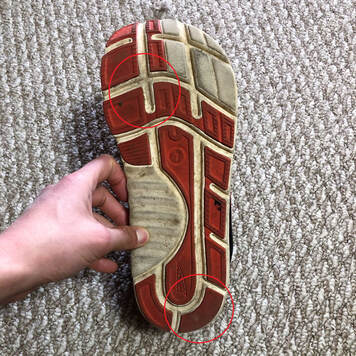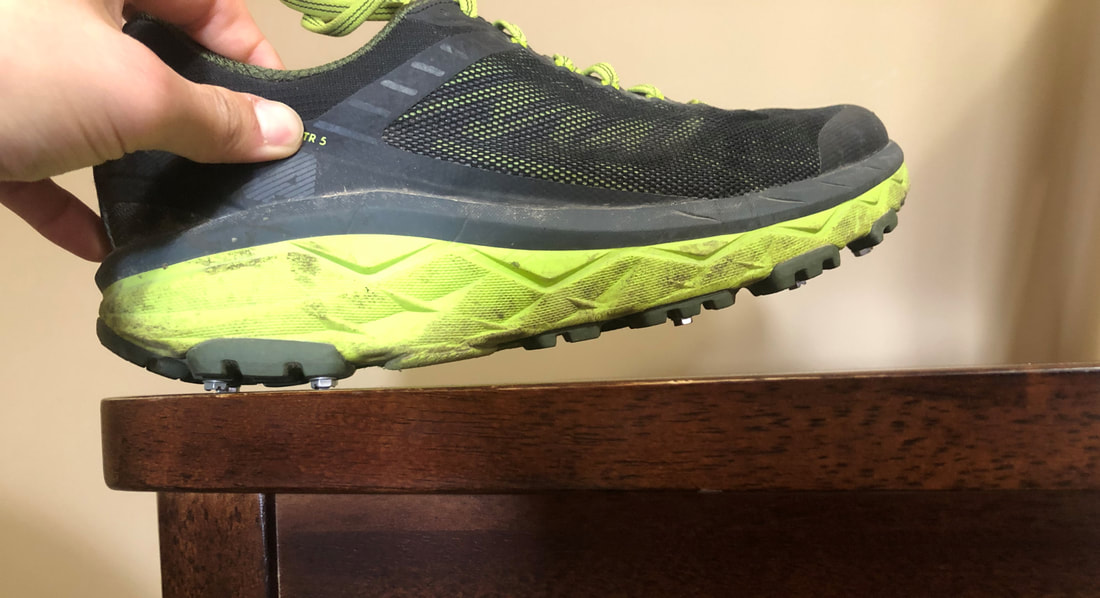IntroductionRunning during the winter months and in the early spring may be great core work, especially as you try not to slip and fall when running on packed snow and ice! There are several ice/snow traction devices for sale out there but my personal favorite, as a DIY'er, has always been Screw Shoes. I like this traction method for these main reasons - 1) effectiveness (they really do bite into the ice!), 2) cost (hex screws are super cheap!), and 3) highly customizable (screws can be placed in any configuration you want!). Matt Carpenter already wrote an excellent article on How to create your own Screw Shoes so my main goal here is to (hopefully) get more into the nitty-gritty on my super-detailed personal process for what size screws I choose, how I decide where to place screws and how many as well as any tips. I am going to show 2 examples to highlight some differences on how outsole design influences where I put choose to put in screws - 1 with a road shoe, which does not have aggressive or pronounced treads (Altra Torins), and 1 with a trail shoe (Hoka Challenge ATR 5), which have more pronounced treads. The key point is to experiment, experiment, experiment!! As screws are cheap, it's a lot more affordable to try out a bunch of things and see what works for you! Let's jump into it! Screw SelectionScrew size choice may be purely personal preference as well as terrain dependent. I tend to like the smaller #6 screws vs the #8 screws that Matt references in his article. This may be because I run more on roads (which get icy, with a little less packed snow) as well as smoother, less technical trails than maybe Matt does. You may need bigger, beefier screws, if you are running in the mountains of CO or in lots of packed snow. Note: You don't have to use only one screw size!! I sometimes use a combination of #6 screws (less obtrusive on the balls of the feet in front) and #8 screws (towards the rear of the shoe for more traction). Experiment! I recommend 3/8" or 1/2" lengths but be sure to do a rough measure of the thickness of your midsole/outsole to make sure you don't screws that are too long. If you are lighter on your feet and do less pushing off, you can probably get away with shorter screws without them popping off. So far, I have not really had a screw pop out on me yet. *knock on wood* Screw size also determines the height of the screw head, which may be a factor in how and where you place your screws. Screwing onto the lugs provide the most protrusion, which can be helpful in packed snow. I don't think you need more than a couple of mm of screw head for it to be able to "bite" into the ice. Screwing in between the lugs may give your outsole a bit more life as well as be able to leverage your outsole lugs (if you have them) for traction in regular or packed snow.
Screw PlacementFrom my experience, a good first step in determining screw placement is to review your shoe wear patterns, which can indicate where your feet usually contact the ground (are you a heel-striker/scuffer, like me, or a mid/fore-foot striker) and where your feet pushes off the ground. Those are the points where you can benefit the most with added traction. Usually the middle of the shoe does not need many screws, if any, because the balance phase of the gait/stride mechanics has the force directed perpendicularly to the ground so (in that split-second) your foot really isn't going anywhere, until it transitions into the push-off phase (and then you will need traction again). Take terrain or gradient into account as well, if you run on hills a lot. Most people tend to transition to a heel strike on downhills (as they lean back a bit) and go up on their forefoot when going uphill. Since I'm going downhill a lot faster than I am going up, the consequences for me slipping and falling on a downhill are probably more severe so I definitely emphasize some beefier screws on the back. The number of screws is pretty much personal preference. More is not necessarily better, especially if they start to interfere with your stride mechanics. Matt in his article uses 16-18. I personally have found that to be too much, especially in the middle forefoot area, and have found 10-12 to be a happy medium. I usually go 6-8 in the front and 4-5 at the back. It also helps to take into account the shape of the shoe and how that affects your gait. The Hoka Challenger (below, left) has more of a distinct rocker shape than the Altra Torins (below, right). This means there is less of a mid-stance, balance phase and any screws placed on the heel will definitely have less, if not zero, impact when transitioning from rear-foot to fore-foot. This means that you may need a few screws closer to the middle of the shoe. If you have a thinner shoe or a shoe with less cushioning or less stiffness, this may start to rub into your arch so just be aware.
Here are a few tips! 1. Many shoes have deceiving outsoles/midsoles where your foot actually sits lower in the shoe than the midsole height from the outside will lead you to believe. Remove your insole BEFORE you start screwing the screws in so that, in case you select screws that are too long, they don't rip through your insole. You can also run your hand into your shoe to feel for any bumps or actual screw protrusions. 2. Experiment, experiment, experiment! After initial screw installation and before you first real run, take your screw shoes out for a few steps or a short run around to see if your screws are pushing on your feet in an uncomfortable way. Good news is, if there are, you can just move them! Customizability, FTW! 3. There are now trail shoes with features built in to optimize customizability like the Saucony Peregrines and Mad River TRs. These shoes now have spots, specifically for users to install #8 screws as well as drill out additional drainage holes (which is a tip/hack for another post!). This could be very helpful for runners and help make installing screws more straightforward. For me, I personally like the flexibility but if the configuration works, why not? (pictures below courtesy of Saucony's website - Peregrines (left) and Mad River TR (right).) There you have it! A (probably too) in-depth "analysis" of how to make your own screw shoes and how to determine optimal screw placements when you do so. Let me know what you think and please leave any feedback on if you have tried screw shoes and what works (and doesn't work) for you!
7 Comments
Big confession - For the first time in 3 weeks, last Saturday, I ran. With moving to Louisville, KY in the past 3 weeks and settling into our new house, amidst COVID-19 and the heat and humidity of summer, I have run once in the last 3 weeks. If I were coaching myself (which I am), I would be very concerned as well when I see something akin to this sea of red in Training Peaks. With everything going on (the heat and humidity of the summer, races being cancelled due to the coronavirus and urges to quarantine and social distance), it is totally understandable that motivation is probably at an all-time low for most people, myself totally included. With moving into a new house and being a first-time homeowner, the cleaning and unpacking never ends! There is always something else to take care of. If there isn't a race to train for, what is the point? I mean, even virtual races have that much less accountability and camaraderie to keep things going. When you are truly on your own, how does one maintain or start up again the drive to keep running or working out? All this brings me to my (potentially) controversial point - motivation is a bunch of crap.
Motivation can be powerful, but transient. Motivation is fleeting - here one day, gone the next. As Ken Chlouber says it so well in this awesome, inspirational pre-Leadville 100 speech - "Motivation will not get you to the finish line. Motivation will desert you when you need it the most. If you are counting on motivation, forget it." In that same video, he goes on to say, "The one thing that will get you to that finish line is total commitment." However, life happens, sometimes other things take higher priority and we have to manage/juggle our commitments. After all, it is just running. Right? After some time away from it, though, the hunger and the wondering start to come back but what is the motivation? Right now, there really is none. Maybe fear, fear of losing all of that fitness that I have worked for over the years but fitness doesn't last that long and I lose a lot of it every winter anyways. So what prompted me to lace up and go out the door? It was commitment to an idea, or rather, a renewal of a commitment to an idea that I have tried to share with all the athletes I coach - Do something every day that makes you a better athlete. For runners, you may think that this means running every day but nothing could be further from the main point. The act of running itself is a small part, albeit important, of everything that goes into making someone a better athlete. If you need it, taking time off to do some active recovery and to heal will make you a better athlete in the long run. So is taking time to stretch, to do yoga, to cross-train, to strength train, etc. Something is better than nothing and it really helps avoid feelings of failure and disappointment if you accomplish something every day. Couldn't go out for a run but decided to do yoga instead? AWESOME! You are now more flexible and your muscles are looser and maybe your core is stronger too! Didn't go out for a run but decided to eat an entire pepperoni pizza by yourself? ....Carbo-loading for something? :D What this means for me is getting back to a routine of getting runs in, doing yoga, stretching, foam-rolling and making some time every day for one or more of these activities so that I continue back on the path of becoming a better athlete. Nothing is really motivating me at this point as I am not signed up for any races. I don't have running groups to run with or anyone else. It's a bajillion degrees outside with the humidity of sweaty armpits. What gets me out is just committing to doing something. Sometimes we need breaks from long-term commitments to ourselves (case in point) and that's okay as long as we take a chance to revisit these commitments and renew them periodically. They may be a bit arbitrary, as long as it means something to us. This idea of becoming a better athlete means something to me as I still have bucket list goals I want to accomplish. It also helps to share these commitments with others so that there is some external accountability so let me ask you this, reader, - "What have you done today that will help make you a better athlete/runner/person/whatever you want to be?" |
Chris NeohTrail/ultra runner, Designer, Foodie, Rock Climber, World Traveler, Triathlete, Level 1 RRCA-certified coach, NASM-Certified Personal Trainer (CPT) and Corrective Exercise Specialist (CES) ArchivesCategories |
Copyright © 2020 The Growth Experience, LLC / ChrisNeohCoaching, LLC




















 RSS Feed
RSS Feed

